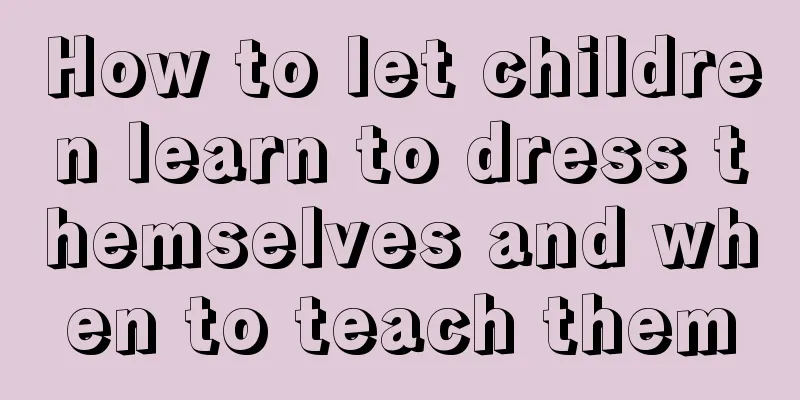How to let children learn to dress themselves and when to teach them

|
As time goes by, children will start to want to dress themselves and choose clothes and accessories. This is normal. Parents can encourage children to practice more, and children will also use their imagination and artistic sense through the process of dressing. So how can we let children learn to dress themselves? When is the best time to teach them? Children's Dressing Stages Babies under one year old: Babies under one year old are obviously not very involved, but you will find that they are watching you when you help them change their clothes. They will learn how to dress by watching you. Between one and two years old: After the child is one year old, he will start to practice what he learns by watching, but at the beginning, he can only practice taking off clothes, hats and socks. As time goes by, he will stretch his arms when dressing and want to try to dress himself. Between two and three years old: After about two years old, you will find a big change in your child. He will want to develop his independence. He may use these costumes more often by himself. For example, he will put on and take off shoes, put on socks, unbutton, etc. Between three and four years old: After the age of three, the intention to show independence is more obvious, and it may even be combined with new motor skills. The child can put on clothes by himself. He will use zippers and use belts, buttons and other items. Between four and five years old: When the child reaches the age of four, he should be able to dress himself at any time, and they will want to choose their own clothes. You should encourage him to express his personality. Benefits of children learning to dress themselvesHand-eye coordination: When children pick up clothes to put on, the coordination between eyes and hands must be balanced to put them on. If the hands and eyes are not coordinated, children may spend more time observing.Hand muscle development: When children put on or take off clothes, using buttons, belts, socks, etc. will exercise the muscles of the hands. Try to put them on many times, and the fingers will be flexible.Artistic beauty of dressing: When children grow up, they will begin to want to decide what to wear by themselves. At this time, they will show their artistic beauty and imagination, and choose their favorite clothes and accessories to wear.Exercise cognitive development: Children will understand the names and wearing methods of different clothing parts and accessories, such as clothes, pants, socks, etc., by wearing and matching clothes by themselves.Exercise independent characteristics: Through the process of dressing and matching clothes by themselves, children will learn to be independent. Slowly, they will begin to understand that they can make decisions for their own behavior and be responsible for it.How to let children dress themselves Make children feel happy to dress: When dressing your baby, if he doesn't want his mother to wear him, you can say to him: "Stretch out your little hand and let your mother kiss it." When your baby reaches out his hand, you can really kiss him, then take the opportunity to put his arm into the sleeve, and praise him for doing a good job. The baby will be very happy and think that dressing is a happy thing. Let the baby feel that dressing is fun: When you dress your baby, you should talk to him and sing to him. You can also give him some fun things to play with, such as hand-cranked toys with sound, pictures, cloth animals, etc., so that he will feel that dressing is as fun as playing games. Give some prompts when dressing your baby: When you dress your baby, let him hum after you: "Let's put on socks, put on socks, put on socks. We can put on socks quickly..." The baby will eventually understand what you mean and understand the order of dressing. Train your baby's dressing skills: When the baby expresses that he wants to dress himself, let him practice with a doll, first take off the clothes for the doll, and then put them on. Praise him every time he completes a step, and give him the opportunity to practice more. Let him practice buttoning, zipping, hooking pants and unbuttoning, and finally practice tying shoes. Be patient and don't expect him to learn quickly because he is still young, but he will learn it eventually. Choose the right clothes: You should choose clothes that are easy to put on and take off for your baby. Elastic skirts and pants and pullover shirts are easy for babies to put on and take off, while button-up coats or ski suits with zippers are more difficult to deal with. After he can handle simple clothes easily, gradually let him wear more complicated clothes. Let your baby learn from his mother: Babies like to do everything like their parents. If you dress your baby while demonstrating, your baby will like to learn. This will not only help your baby learn the correct way to dress, but also make him get used to dressing quickly. Practice dressing skills: Morning time is short and often there is no time. So find a free time during the day, sing happily, and teach him easily. |
<<: How can parents regulate their children's Internet access and monitor their safety?
>>: How should parents deal with the problem of children's sex education enlightenment?
Recommend
Should I wear a hat during confinement in winter? What kind of hat should I buy during confinement in winter?
Wearing a hat during confinement is a traditional...
Why are early childhood education classes so expensive? How to choose an early childhood education course?
Early childhood education courses are becoming mo...
How long is the appropriate time for a newborn to feed breast milk?
The baby is not long old, and the mother has to p...
Many primary school students in Jiangsu suffered nosebleeds. What is the truth behind the shutdown of a nearby chemical factory?
Whether it was yesterday or today, we saw that du...
How to open Liby dishwashing liquid? Which type of Liby dishwashing liquid is the best?
Liby dishwashing liquid is something that everyon...
Can I eat oyster mushrooms during confinement? Can I eat oyster mushrooms during confinement?
During the confinement period, women are relative...
Do babies need pillows? At what age can babies use pillows?
At what age can babies use pillows? Adults cannot...
How to prevent and treat paronychia in children
Paronychia in children seriously affects their mo...
How can we reduce the incidence of baby spitting up? What should we pay attention to after the baby spit up?
The baby's stomach is very fragile. Once ther...
What is parent-child yoga? What are the benefits of parent-child yoga?
With the popularity of parent-child games, parent...
Can I take injections to treat severe pregnancy reactions? Can I take medicine to treat severe pregnancy reactions?
Usually most pregnant women will experience pregn...
How can women prevent vaginal itching and properly care for their private parts?
Women's private parts are always itchy or sme...
How to let children learn to dress themselves and when to teach them
As time goes by, children will start to want to d...
What is the chance of pregnancy after IUD insertion? How to get an IUD insertion certificate?
Recently, I heard that some female friends around...
Can I eat ginseng fruit during breastfeeding? Is it good to eat ginseng fruit during breastfeeding?
Diet during breastfeeding is very important, beca...









